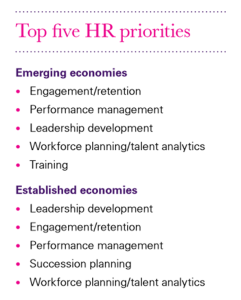SHL has just published their fascinating yearly report on global assessment trends.
Acquired last year by CEB, SHL is an assessment company, so reporting on assessment trends is right up their alley. The survey data is interesting and the conclusions are worth noting by anyone in HR.
But their questions and conclusions go way beyond the use of assessment instruments for employment selection and employee development strategies and practices.
Top 5 HR priorities
The first part of the report reviews organizations’ talent management focus and landscape. For example, the authors compare the top five (5) HR priorities in emerging economies to the top 5 HR priorities in established economies.
The lists are similar but not identical. You can see (left) that four of the priorities show up on both lists, although prioritized differently; and that succession planning shows up in the top 5 on the established economies list, while training shows up in the top 5 on the emerging economies list.
Other findings relate to HR’s use of big data and the perception that there is room for improvement around the world in using objective data to make workforce decisions. In fact, less than 25 percent of the survey respondents reported that their organizations have a clear understanding of workforce potential.
The second part of the report focuses on the assessment of talent – both for hiring and for employee development. Interesting findings in this section include the desire by nearly 75 percent of respondents to improve talent measurement and the practice of linking pre-hire and post-hire testing to specific business outcomes.
The third part of the report focuses on technology in testing, with a specific focus on mobile devices and social media. The key findings here include data showing that emerging economies want to use mobile technology assess candidates – both recruiters and candidates want this capability; and social media data is becoming less critical to hiring decisions. (See last week’s Data Point Tuesday.)
4 recommendations for HR
The report concludes with four recommendations for HR in 2013:
- Big data presents HR with a unique opportunity to demonstrate business value.
- Only the right data will lead to the success of talent initiatives.
- HR should embrace innovation that improves how talent is recruited, but with caution.
- Mobile technology should be considered for competitive advantage, not to follow the crowd.
The data in this report is presented in a way that is easily understood and useful. At 30 pages, it’s worth the 45 minutes it will take to scan it and then hone in on the impactful sections. I especially appreciated the selected references at the end, as well as the key findings lists from the same survey reports for 2009 – 2011. I’m always interested in the evolution of these kinds of lists.
But the bottom line for me is that here’s yet another source of global HR data shining a light on HR’s need to figure out how to demonstrate its business value. Whether you prefer this report to others you’ve discovered here (either here at TLNT or at Data Point Tuesday on ChinaGorman.com) — or you prefer other sources of HR data and analysis, the drum beat is the same: aligning HR strategy (and tactics) to business outcomes is the only way to demonstrate business value.
And the only way for HR professionals to be seen as business leaders.
This originally appeared on China Gorman’s blog at ChinaGorman.com.
